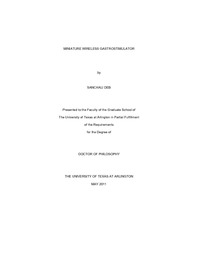
ATTENTION: The works hosted here are being migrated to a new repository that will consolidate resources, improve discoverability, and better show UTA's research impact on the global community. We will update authors as the migration progresses. Please see MavMatrix for more information.
Show simple item record
| dc.contributor.author | Deb, Sanchali | en_US |
| dc.date.accessioned | 2014-03-10T21:03:42Z | |
| dc.date.available | 2014-03-10T21:03:42Z | |
| dc.date.issued | 2014-03-10 | |
| dc.date.submitted | January 2011 | en_US |
| dc.identifier.other | DISS-11119 | en_US |
| dc.identifier.uri | http://hdl.handle.net/10106/24020 | |
| dc.description.abstract | Gastroparesis is a common disorder caused to patients suffering from diabetes, cancer and Parkinson's disease. Gastric electrical stimulation (GES) has attracted significant attention in the treatment for Gastroparesis. GES inflicts electrical pulses to the stomach tissues to help regain normal motility and hence reduces Gastroparesis symptoms like vomiting, nausea, abdominal bloating etc. Conventional gastric stimulator needs a long surgery to be implanted and it is a big pacemaker like device that runs by a non-rechargeable battery. It has to be replaced once the battery gets exhausted. Hence another round of surgery is done when these devices are needed to be replaced and re-implanted. This takes the toll over the patients both physically and financially. Most of the times the insurance companies deny to bear the cost and hence the patient cannot afford a treatment. In this work, two miniaturized wireless gastric stimulators for delivering GES as long-term implants have been designed and demonstrated. These devices are designed as such that they can be implanted through endoscopic implantation and the patients do not need to undergo any surgery at all for the implantation. Wireless telemetry for both devices is based on inductive coupling at a carrier frequency of 1.3 MHz from an external transmitter which delivers power. One design embodies a rechargeable battery with a circuitry to recharge the battery. The magnetic coupling is used to turn the device ON and OFF. The second device is completely batteryless with a circuitry to harvest the radio-frequency energy in real time. Both the circuits were made on printed circuit boards which consisted of microcontroller and many other discrete components. These were coated with biocompatible polymer to protect the implant circuitry from the gastric fluids or any other medium that is present in the stomach. The transmitter consists of a class-E amplifier model and resonance circuitry. An optimization procedure was investigated for achieving the maximum wireless energy transfer for the radio-frequency inductive coupling. The devices have been tested on an acute pig model and Electrogastrogram (EGG) signals of the stomach were recorded. The stomach motility was monitored based on the frequency and amplitude of the myoelectrical pulses and also their consistency. The output voltage was also noted to analyze the power delivery to the tissues. These experiments revealed favorable and significant impacts on the gastric electrical activity.Once the devices were tested surgically, a series of animal experiments were performed on porcine model to demonstrate the feasibility of the device implantation through endoscopy. Several endoscopy procedures were investigated successfully to provide many possibilities of implantation for the doctors. Endoscopic implantations are outpatient procedures and thus by implanting it endoscopically any surgery need can be avoided. | en_US |
| dc.description.sponsorship | Chiao, Jung-Chih | en_US |
| dc.language.iso | en | en_US |
| dc.publisher | Electrical Engineering | en_US |
| dc.title | Miniature Wireless Gastrostimulator | en_US |
| dc.type | Ph.D. | en_US |
| dc.contributor.committeeChair | Chiao, Jung-Chih | en_US |
| dc.degree.department | Electrical Engineering | en_US |
| dc.degree.discipline | Electrical Engineering | en_US |
| dc.degree.grantor | University of Texas at Arlington | en_US |
| dc.degree.level | doctoral | en_US |
| dc.degree.name | Ph.D. | en_US |
Files in this item
- Name:
- Deb_uta_2502D_11119.pdf
- Size:
- 20.03Mb
- Format:
- PDF
This item appears in the following Collection(s)
Show simple item record


